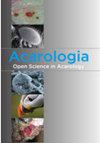标题巴西捕蝇属一新种和丹麦螯蝇属一新种(中刺目:捕蝇科)
IF 0.9
3区 农林科学
Q3 ENTOMOLOGY
引用次数: 0
摘要
为了了解来自巴西的Gamasina(中柱头虫)土壤螨的动物群,发现了Arrenoseius robertogonzalezi Trincado和Martin,2018,仅从智利的原始描述中得知。为该物种提供了补充的形态信息。同样,发现了一个新物种,Chelaseus pluridentatus n.sp.,并在这里进行了描述;它与其他Chelaseus Muma和丹麦物种的区别主要在于固定的螯趾上有更多的牙齿,7个而不是2-5个。还提供了世界物种Chelaseus的钥匙。本文章由计算机程序翻译,如有差异,请以英文原文为准。
A new record of an Arrenoseius Wainstein species and a new species of Chelaseius Muma and Denmark (Mesostigmata: Phytoseiidae) from Brazil
In an effort to understand the fauna of Gamasina (Mesostigmata) edaphic mites from Brazil, Arrenoseius robertogonzalezi Trincado and Martin, 2018, known only from the original description from Chile, was found. Complementary morphological information is provided for this species . Likewise, a new species, Chelaseius pluridentatus n. sp. was found and is here described; it is distinguished from other Chelaseius Muma and Denmark species mainly by having more teeth on the fixed cheliceral digit, seven instead of 2–5. A key to the world species of Chelaseius is also provided.
求助全文
通过发布文献求助,成功后即可免费获取论文全文。
去求助
来源期刊

Acarologia
ENTOMOLOGY-
CiteScore
2.00
自引率
18.20%
发文量
81
期刊介绍:
Acarologia is a free open-access journal. Please help us by submitting manuscripts in accordance with following instructions.
All manuscripts which do not conform to the instructions will be returned to authors without the benefit of review.
Acarologia publishes the results of original research on all aspects of Acarology.
The journal policy is that taxonomic descriptions should include several species within a same genus/family, when possible.
The editors reserve the right to refuse manuscripts when authors intentionally divide individual species descriptions of the same genus/family into distinct publications.
Single species descriptions should be clearly justified based on their scientific interest.
 求助内容:
求助内容: 应助结果提醒方式:
应助结果提醒方式:


